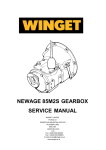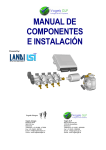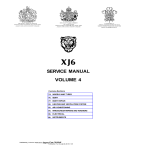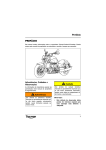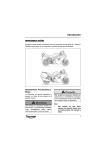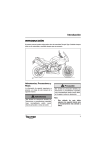Download 1 Triumph Explorer Service Manual Contents
Transcript
1 Triumph Explorer Service Manual Contents 1 Triumph Explorer Service Manual .............................................................................................. 1 1.1 Introduction ....................................................................................................................... 4 2 Non Service Work ...................................................................................................................... 7 2.1 Fluids, Service Limits, Pressures, Weights ........................................................................... 7 2.2 Loosening & Tightening Sequences .................................................................................... 8 2.3 Greasing Threads ............................................................................................................... 8 2.4 Electrical Connectors.......................................................................................................... 9 2.5 Tools .................................................................................................................................. 9 2.6 Test Ride .......................................................................................................................... 12 2.7 Fault Finding .................................................................................................................... 13 2.8 Removing Bodywork Panels ............................................................................................. 15 2.8.1 Rear Cowling ............................................................................................................ 15 2.8.2 Beak ......................................................................................................................... 16 2.8.3 Tank Side Panels & Radiator Shrouds ........................................................................ 17 2.8.4 Fuel Tank .................................................................................................................. 20 2.9 Brake Caliper Removal ..................................................................................................... 24 2.9.1 Front ........................................................................................................................ 24 2.9.2 Rear ......................................................................................................................... 25 2.10 Brake Disc Replacement ................................................................................................... 25 2.10.1 Front ........................................................................................................................ 26 2.10.2 Rear ......................................................................................................................... 27 2.11 Changing Bulbs................................................................................................................. 28 2.11.1 Headlight .................................................................................................................. 28 2.11.2 Sidelight ................................................................................................................... 29 2.11.3 Taillight .................................................................................................................... 29 2.11.4 Indicators ................................................................................................................. 30 2.12 Altering The Air-Gap Behind The Screen ........................................................................... 31 2.13 Installing A Rear Power Outlet .......................................................................................... 32 2.14 Removing & Installing Wheels .......................................................................................... 33 2.14.1 Front ........................................................................................................................ 33 2.14.2 Rear ......................................................................................................................... 34 2.15 Removing & Refitting Brake Pads And Cleaning Brake Calipers ......................................... 35 2.15.1 Front ........................................................................................................................ 35 2.15.2 A.001 Rear ......................................................................................................................... 37 Page 1 of 120 2.16 Rear Shock Removal & Replacement ................................................................................ 39 3 Every 1 Year or 10,000 Miles – Whichever Comes First ............................................................ 41 3.1 ECU Connection Tool ........................................................................................................ 41 3.2 Reset The Engine Service Indicator ................................................................................... 41 3.3 Reset The Stored Adaptations Table In The ECU ............................................................... 42 3.4 Engine - Check For Leaks .................................................................................................. 43 3.5 Engine Oil & Filter - Renew ............................................................................................... 44 3.6 Autoscan - Carry Out A Full Autoscan Using The Triumph Diagnostic Tool And ABS & Immobiliser ECMs - Check For Stored DTCs .................................................................................. 46 3.7 Cooling System - Check For Leaks ..................................................................................... 48 3.8 Coolant Level – Check / Adjust ......................................................................................... 49 3.9 Fuel System - Check For Leaks / Chafing ........................................................................... 50 3.10 Lights, Instruments And Electrical Systems - Check ........................................................... 51 3.11 Steering - Check For Free Operation ................................................................................. 52 3.12 Headstock Bearings – Check / Adjust ................................................................................ 53 3.13 Forks - Check For Leaks / Smooth Operation .................................................................... 54 3.14 Brake Fluid Levels - Check ................................................................................................ 55 3.15 Brake Pads - Check Wear Levels ....................................................................................... 56 3.16 Brake Master Cylinders - Check For Fluid Leaks ................................................................ 56 3.17 Brake Calipers - Check For Fluid Leaks And Seized Pistons ................................................ 57 3.18 Fasteners - Inspect Visually For Security ........................................................................... 58 3.19 Wheels - Inspect For Damage ........................................................................................... 60 3.20 Wheel Bearings - Check For Wear / Smooth Operation ..................................................... 61 3.21 Tyre Wear / Tyre Damage - Check .................................................................................... 62 3.22 Tyre Pressures - Check / Adjust ........................................................................................ 63 3.23 Clutch - Check Operation .................................................................................................. 64 3.24 Clutch Master Cylinder - Check For Leaks ......................................................................... 64 3.25 Clutch Fluid Levels - Check................................................................................................ 65 3.26 Final Drive - Check For Oil Leaks ....................................................................................... 66 3.27 Final Drive Oil – Renew..................................................................................................... 67 3.28 Stand - Check Operation ................................................................................................... 69 3.29 Exhaust Clamp Bolts - Check / Adjust................................................................................ 69 3.30 Accessory Rack Sliding Carriage - Check For Correct Operation – ...................................... 70 3.31 Accessory Pannier Link Bar - Check For Correct Operation And Adjustment ...................... 71 4 Every 10,000 Miles................................................................................................................... 72 4.1 4.2 4.3 4.4 4.5 Miles) 4.6 4.7 4.8 Removing The Airbox ....................................................................................................... 72 Running The Engine With The Fuel Tank Removed ........................................................... 73 Removing The Cylinder Head Cover .................................................................................. 74 Camshaft Timing - Adjust - Only At First 10,000 Miles ....................................................... 77 Measuring And Setting Valve Clearances (First At 10,000 Miles And Then Every 20,000 80 Air Cleaner - Renew .......................................................................................................... 90 Spark Plugs - Check .......................................................................................................... 91 Throttle Bodies - Balance ................................................................................................. 92 Page 2 of 120 4.9 Throttle Body Plate (Butterfly) – Check / Clean ................................................................. 95 5 Every 20,000 miles ................................................................................................................... 96 5.1 Spark Plugs - Renew ......................................................................................................... 96 5.2 Headstock Bearings – Lubricate And Retension ................................................................ 97 5.3 Rear Suspension Linkage – Check / Lubricate – ............................................................... 101 5.4 Secondary Air Injection System - Check .......................................................................... 105 6 Every 40,000 miles ................................................................................................................. 106 7 6.1 Fork Oil – Renew ............................................................................................................ 106 Every 2 Years, regardless of mileage ...................................................................................... 111 7.1 Brake Fluid - Renew........................................................................................................ 111 7.2 Clutch Fluid - Renew....................................................................................................... 114 8 Every 3 Years, Regardless Of Mileage ..................................................................................... 116 8.1 Coolant - Renew ............................................................................................................. 116 8.1.1 Draining.................................................................................................................. 116 8.1.2 Refilling .................................................................................................................. 117 Page 3 of 120 1.1 Introduction Hello and welcome to this Service Manual for the Triumph Tiger Explorer. The aim is to guide you through carrying out all of the items listed in the service schedule. Further chapters also discuss non service based work that you may wish to carry out like for example changing the rear shock absorber for an aftermarket one. If you plan to carry out routine servicing work on your bike then this manual is all you need, however it does not cover work inside the engine cases other than setting the valve clearances and adjusting the valve timing. I have chosen to take this stance as I believe it covers the work that 90% of owners will do, 90% of the time. If you do need to replace a con rod or a gearbox cog, then for now at least you will still need the Triumph Factory Workshop Manual, but then if you’re one of the 10%ers who delves deep inside the engine cases then I guess you’ll have the Factory Manual on your bookshelf anyway. The approach taken is practical and informal, and discusses the work from a home mechanic’s perspective. Plenty of pictures are included identifying which bolts to undo and which parts to remove. Wherever special tools are required, suggestions are given for making your own alternative tools that will accomplish the job equally well for a fraction of the cost of the Triumph factory tools. If you want to buy a complete set of the replica factory tools, I am making and selling sets containing the following tools: · · · · · Crankshaft locking pin – used when setting the camshaft timing & valve clearances Camshaft locking bar – used when setting the camshaft timing Fuel tank electrical harness – used to run the engine with the tank removed when setting throttle balance Fuel tank petrol pipe – used to run the engine with the tank removed when setting throttle balance Further tools may be added if demand exists Please contact me by email at [email protected] to inquire about buying a set of tools. Where there are a number of ways of accomplishing a task, I try to offer guidance on the alternatives and discuss the pros and cons of each method. With a manual such as this which will be read by many owners of various experience it is difficult to pitch it at the right technical level – what will be necessary to the novice will be boring and tedious to the experienced home mechanic. Similarly assuming knowledge that the most experienced will take for-granted would result in a manual that is incomprehensible to those just starting out on the path of home servicing. I have tried to address this by grading the difficulty of each task and then describing every new task from first principles. Those with less experience can then start working through level 1 tasks before progressing onto level 2 tasks when they feel comfortable to do so. When an experienced mechanic is working through the more basic tasks it may well be enough to scan quickly through the workflow and then just look at the torque settings. Page 4 of 120 If you feel that more detail is necessary to cover certain tasks then please contact me at [email protected] . If there is a general consensus amongst readers that some sections would benefit from further description then I will write supplementary detail which will be sent out free of charge to anyone having already bought a manual. All of these future addendums will be included in forthcoming reprints of the manual. The Explorer is no more complex than any other modern bike to work on, however one of my mantras when carrying out any work is to ‘know your own limitations’. With many aspects of servicing the bike you will pass a point of no return and it will simply not be possible to ride the bike to the dealer to get him to finish it for you. Eg if you pump a brake piston out and aren’t happy bleeding the system afterwards, what do you do? Similarly if the cams are out and you don’t feel happy putting them back, what do you do? It is also essential that anything you attempt is completed properly. This includes tackling work in the correct sequence, doing it correctly, and doing it all. Mistakes vary from annoying to fatal, passing through expensive on the way, although if you achieve the f word then you’ll be past worrying about the expense. It is very important to have read the instructions from beginning to end before starting out on any job and to have all tools and spares required readily to hand. A good set of spanners and sockets is a must, but in reality the Explorer does not need too many specialist tools, and most of the specialist tools listed in the manual can be made fairly easily. If the above puts you off, sorry but it’s better to be scared off than to start something you may live to regret, but for anyone with the confidence to carry on there’s a lot of satisfaction (and money to be saved) in doing the job yourself, so here goes. Every task described below has a task duration and a skill level. The time assumes a level of skill appropriate to the task and going at an easy pace, not rushing through the work. It does not include cleaning up time afterwards. The skill levels are: 1 Basic tasks requiring no skills or previous experience 2 Simple tasks requiring only a basic level of skill and little previous experience 3 Intermediate work for anyone with a growing experience and keen-ness to learn 4 Major tasks for enthusiastic amateurs with significant experience 5 Serious work for experts only All references to the Right and the Left of the bike are from the rear of the bike looking forward. Apart than when changing the engine oil and filter, no work should be undertaken with the motorcycle engine hot. Severe burns will result from touching hot components. Remember that some parts will remain hot after others have cooled. When working on the bike, have the owners handbook available. It gives useful information regarding fuses, adjusting the headlight aim and so on. That information is not reproduced in this manual. Page 5 of 120 Torque settings are taken from Triumph information on the subject. Figures given in Lbft are calculated and rounded to the nearest whole number. This manual is an original work and all text and photographs remain the property of the author. Reproduction either in whole or in part is not allowed except with written permission. Disclaimer – This service manual is intended to guide you through servicing the Triumph 1200 Tiger Explorer and is meant to supplement your existing knowledge and to complement the Triumph Workshop Manual. I hope that you will find the following useful but please remember that it’s your hands on the spanners not mine - every effort is made to ensure that information contained in the manual is correct, but no responsibility can be taken for any resulting damage to the motorcycle or personal injury. Please also be aware of your personal safety. Many of the fluids in the motorcycle can cause damage to the skin after prolonged contact and can cause injury if allowed into contact with the eyes or swallowed. It is a good idea to wear safety glasses when dealing with anything that may splash – a surprisingly small amount of petrol in an eye will cause a surprisingly large amount of pain. This manual is written whilst I work through a full service on my 2012 UK specification bike. Whilst the same basic service work is required in all markets, and all of the torque settings and major parts are the same, the detail and exact specification and standard equipment fitted may vary from one market to another. I am writing this based on my own professional engineering background and my experience of working on my own bikes & cars since 1988. I am not employed by Triumph or one of its dealers. Mark Barrett Bath, UK, February 2013 Page 6 of 120 2 Non Service Work 2.1 Fluids, Service Limits, Pressures, Weights Description Recommended Type Quantity Engine oil after engine rebuild Engine oil after filter change 10W40 or 15W50 semi or fully synthetic oil that meets or exceeds API-SH and JASO MA 75W90 Fully synthetic hypoid oil meeting API Service level GL5, eg Castrol SAF-XO 4.5l Final drive 4.0l 0.17l It is not recommended to add any sort of low friction or long life additive to the engine or final drive oil. Cooling system HD4X Hybrid OAT coolant 2.4l when drained fully Do not top up the coolant with water, use only the recommended coolant, undiluted. Fork oil Fork oil - oil level KHL 15-10 (Equivalent to 5wt) Fork fully compressed, no spring Brake / Clutch Fluid DOT4 664ml per leg (approx) 117mm Do not mix DOT 4 and DOT 5 brake fluid Spark Plug NGK CR8EK 3 Front disc thickness Rear disc thickness Service limit Service limit 4.0 mm 5.0 mm Front disc runout Rear disc runout max max 0.3 mm 0.25 mm Pressures Front Tyre Rear Tyre 36 psi 42 psi Weight Wet Weight 259 kg Payload (rider, passenger, luggage & accessories) Max Battery YTX20L-BS 222 kg Page 7 of 120 2.2 Loosening & Tightening Sequences When removing and replacing any part, it is desirable to stick to the following such that loads are uniformly removed and applied. When loosening or tightening any fixings that are tightened to more than about 30Nm (22Lbft), it is advisable to part loosen all bolts in stages, so that the load is gradually removed across the whole part instead of completely removing the bolts one at a time. Similarly when tightening fixings, part tighten all bolts in sequence then fully tighten in the same sequence. When a part has a number of fixings it is advisable to loosen or tighten fixings in a diagonal pattern, as shown in Figure 1. One valid exception to this loosening or tightening pattern is when bolts of two or more different sizes are used to fasten a single part. In this case loosen all of the smaller bolts before loosening the larger diameter bolts. This will allow the larger bolts to take the strain of the smaller bolts as they are removed. If the Figure 1 reverse sequence was followed then the smaller bolts would be required to take the strain of the larger bolts as soon as the larger bolts were removed – possibly leading to the smaller bolts stripping a thread as they are asked to take a load beyond their design limits. Once all bolts are torqued, go round all of the bolts again in the same sequence. Generally as more bolts take up the tightening load, those previously tightened will loosen slightly and need retorquing. Continue to retorque until no bolts need further tightening. 2.3 Greasing Threads Triumph’s own manual provides torque wrench settings for dry threads. To prevent corrosion I apply grease to most screw threads prior to re-assembly. However the effect of the torque setting varies tremendously depending on the amount of grease you apply. I use a varying amount from a thin smear, to completely smothering the threads depending upon where on the bike the fastener is, generally speaking more exposed = more grease. When torquing up fasteners (always use a torque wrench) it is worth reducing the stated torque by 5 – 15% depending on how much grease you apply so that you do not strip the threads. If you feel a thread starting to strip STOP IMMEDIATELY, back the fastener out and re-tighten. If you cannot feel the yield point on a fastener just prior to it breaking, then I suggest you stick half a dozen nuts & bolts in a piece of steel plate and tighten them up until they shear off. If you are very careful you will feel the yield point at which the fastener starts to turn more easily and you will find that about 1/3 of a turn later it will break. Learn to feel for this every time you tighten anything up and if you reach this point then stop before you end up stripping a thread and replacing a part. This is not to say that you should routinely tighten things to this point – rather that you should feel for it so that if you accidentally overtighten a fastener you will be able to stop before any damage is done. Page 8 of 120 When a steel bolt is threaded into an alloy component it is always the expensive alloy part that strips its thread, not the cheap steel bolt. 2.4 Electrical Connectors Triumph uses the Econoseal range of connectors manufactured by AMP. If you are adding electrical accessories to the bike you can find mating halves for these connectors on the Internet. Alternatively I have previously used Amp’s Superseal range of connectors. Both are excellent quality and will provide a durable long term connection that looks and works so much better than simple spade connectors. Low cost crimp tools are available for these connector contacts which will provide a good quality reliable crimp connection. When chasing down an electrical problem, keep in mind that more electrical faults are caused by a poor electrical contact than by failure of a component. If an area of the bike is not working correctly, then it is worth identifying all the electrical connectors associated with that area, opening them up and cleaning all of the contacts. Sometimes this is all that is needed to resolve a problem. For a ‘belt and braces’ solution I smear petroleum jelly inside all electrical connectors to help waterproofing and prevent corrosion. 2.5 Tools A good toolkit is a must before starting any serious work. As a minimum you will need: · · · · · · · · · · · · · · · A 1/2” socket set with sockets between 10mm and 19mm. Additional larger sockets for specialist jobs eg removing top yoke nut and fork tops. A set of allen key sockets with sizes between 4mm and 10mm. A set of allen torx sockets with sizes between TX15 and TX40. A set of ring and open ended combination spanners between 8mm and 19mm An oil filter wrench. A torque wrench suitable for up to 90Nm (66Lbft). A very large torque wrench is not really suitable – if it is capable of twice this torque it will not have the necessary accuracy at low torque settings. A set of screwdrivers with flat blades between 3mm and 6mm wide. A No2 philips screwdriver. A pair of 8” combination pliers. A pair of 6” side cutters. A 17mm hex socket for removing the front wheel. Threadlock – although many different brand and grades are sold, the reality is that you do not need to be too scientific about it. Any generic threadlock is sufficient. A 38mm socket and a 45mm C spanner if stripping and greasing the steering bearings. A tyre pressure gauge. The following is desirable but not strictly necessary: · A 3/8” socket set with sockets between 8mm and 12mm. Page 9 of 120 · · · · · · A 600mm breaker bar with a 1/2” square drive. A 3/8” and 1/2” set of deep sockets between 8mm and 19mm. A set of 8” long nose pliers & side cutters. A set of 6” long nose pliers & combination pliers. A medium weight hammer and a set of drifts. I have a set of car engine pushrods bought for pennies from a breakers yard which have served well as drifts over the years. They are slim enough to fit into most spaces, have hardened ends, and the tip can be cut and shaped to suit a particular job. A rubber mallet helps persuade stubborn parts to fit or release and is kinder than a hammer. Additional ‘nice to have’ items are: · · · · · · Software and a cable capable of reading ECU fault codes. Essential to read fault codes, set service indicator, bleed brakes when the system is drained (not necessary when changing brake fluid in an already filled system) A set of ratchet ring spanners between 8mm and 19mm – do not use for final tightening which could damage the ratchet mechanism. An 1/2” rechargeable or air operated impact gun for undoing stubborn bolts. A simple electrical multi-meter capable of reading 0-15 Volts DC and testing for electrical continuity. A set of special tools for locking the camshafts and crankshaft when setting the timing or valve clearances A camera is useful for recording cable and hose routes before dismantling If getting really serious about long term maintenance: · · · · Tyre levers and a wheel balancing jig for changing your own tyres. You will need a set of large custom cones for balancing the rear wheel as it does not have integral bearings. A set of spring compressor tools for stripping cartridge forks. A 24l air compressor and tool set – useful for inflating tyres, running an air wrench and a blow nozzle to dry the engine after washing or clear dirt out of deep holes eg before removing spark plugs. A motorcycle ramp to let you stand alongside the bike whilst carrying out routine maintenance. When buying tools it is always a good idea to get good quality kit. Cheap spanners and sockets will not fit the bolt heads as well as top quality tools will, making it much easier to round off a bolt head at just the wrong moment (is there ever a right moment?). Personal recommendation from a friend or an internet forum is a useful way to get a range of opinions, but do treat the most severe exponents and critics with caution and try to focus on advice from people expecting the same life from their tools that you do. Whilst I would not advocate buying cheap sloppy fitting tools, remember that a tool which a pro mechanic may criticize for failing after two years might serve the average home mechanic for a lifetime considering the difference in monthly usage. Page 10 of 120 Ebay is a great source of well priced tools, both new and secondhand, and it is particularly easy to compare different versions of the same tool. Often you will see listings for the same tools in the same packaging with just the brand label differing between listings, with huge differences in price. Car boot sales and markets are a good source of cheap tools where a lower quality product will suffice. However I would not buy expensive or electrical tools from these types of vendor as you may struggle to find them again in the event that you want to return a broken tool. Anything boasting a lifetime guarantee has got to be worth a shot – if the manufacturer can be bold enough to put that on the packaging then they must be fairly confident of the product. Finally owners clubs are a great source for those expensive, occasional use, tools where the initial purchase price can be shared by many end users. Page 11 of 120












